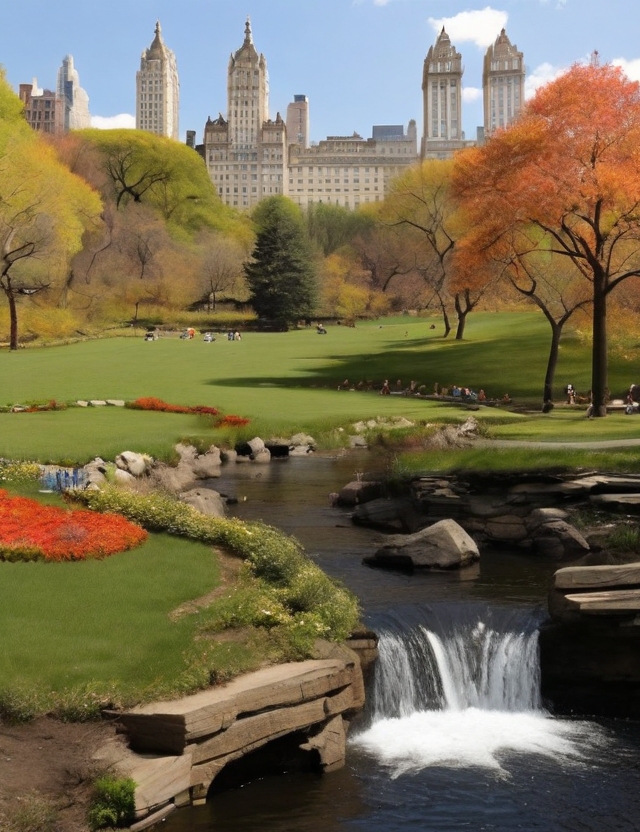
Central Park is an iconic urban oasis in the heart of Manhattan, New York City. It is a popular destination for locals and tourists alike, offering a wide range of activities and attractions throughout its vast acreage. If you’re curious about the size and features of Central Park, you’ve come to the right place. In this guide, we will explore the acreage of Central Park and provide you with quick facts and information about this beloved green space.
Key Takeaways:
- Central Park is an iconic urban oasis in Manhattan, New York City.
- The park spans over an impressive number of acres, making it one of the largest city parks in the United States.
- Central Park features a diverse range of attractions such as lakes, meadows, gardens, and historic landmarks.
- The park was designed by Frederick Law Olmsted and Calvert Vaux and opened in 1858.
- For a city with a large population density, Central Park is an essential green space that provides numerous health benefits and a place for recreation and relaxation.
Understanding the Acreage of Central Park NYC
Central Park is a sprawling urban park located in the heart of Manhattan, New York City. It is known for its vast size, stunning landscapes, and diverse attractions. But just how big is Central Park, and how does it compare to other green spaces in the city?
The park spans an impressive 843 acres and measures 2.5 miles from north to south and 0.5 miles from east to west. To put that size into context, Central Park is larger than Monaco, an independent city-state on the Mediterranean coast, and almost six times bigger than Vatican City!
What’s more, Central Park’s acreage is almost 20 times larger than the City of London’s largest public park, Hyde Park, and 50% larger than San Francisco’s Golden Gate Park. Its extensive size makes it a significant landmark in New York City and one of the largest urban parks in the world.
The significance of Central Park’s acreage extends beyond just its size. The park serves an important ecological function, providing a home for numerous wildlife species and helping to mitigate the urban heat island effect. Additionally, the park provides a much-needed green oasis in the middle of a bustling metropolis, providing residents and visitors with a beautiful space to connect with nature and each other.
Whether you’re exploring one of the many attractions or simply enjoying a leisurely stroll, understanding the acreage of Central Park helps to showcase the remarkable scale and significance of this iconic urban park.
Exploring Central Park’s Size and Features
Central Park is a vast oasis situated in the heart of Manhattan. With its vast acreage, the park offers several serene retreats and various landmarks and attractions that attract visitors from all over the world. Spanning across its 843 acres, Central Park features several sections, including natural habitats, gardens, and open spaces that offer a range of recreational activities for all ages.
Sections of Central Park
The various sections of the park offer visitors different experiences, suiting different preferences.
- Great Lawn: One of the most prominent features of Central Park, the Great Lawn hosts several events such as music concerts, cultural festivals, and movies under the stars during the summer.
- Conservatory Garden: Located in the northeastern part of the park, the garden is a serene spot divided into three sections that feature a variety of seasonal flowers and fountains.
- The Ramble and Lake: This area hosts several species of birds and offers a network of winding trails, a boathouse, and stunning views of the city skyline.
- Zoo and Wildlife Center: The Central Park Zoo and Wildlife Center showcases over 130 species of animals. Visitors can explore the polar bear exhibit, the penguin house, and the tropic zone.
- Bethesda Fountain and Terrace: The terrace offers a beautiful view of the Lake and Bow Bridge, while the fountain displays the Angel of Waters statue and carvings of cherubs.
Design and Purpose
Central Park was designed by Frederick Law Olmsted and Calvert Vaux, who aimed to create an urban oasis allowing city residents to escape the fast-paced city life. The park’s purpose was to provide a serene environment, a place where visitors could unwind and connect with nature. The park’s designers aimed at creating a landscape that would stimulate all senses, combining natural beauty and man-made structures.
Impact on the Surrounding Area
Central Park has become an iconic landmark in New York City, attracting millions of visitors annually. The park’s vast acreage has a significant impact on the surrounding neighborhood, as it provides the area with increased property value and attracts businesses drawn to the park’s immense foot traffic. It’s a beautiful and lush oasis right in the heart of the city, a unique green space that serves as an escape from the urban bustle.
Conclusion
In conclusion, exploring Central Park NYC can be a surreal and cherished experience for anyone who visits. Covering a vast expanse of land, the park offers not only a splendid natural haven but a place of attraction and relaxation. Its strategic location amidst the bustle of Manhattan makes it a must-visit location for tourists worldwide.
Central Park’s size, beauty, and features make it a remarkable landmark and an essential part of New York City’s identity. It provides ample opportunities for outdoor recreational activities, educational trips, and social gatherings. From the well-manicured gardens to the serene lakes and the historic bridges, Central Park retains its charm throughout the year.
In essence, whether you’re a nature lover, art enthusiast, or a history buff, Central Park has something for everyone to enjoy. It’s no wonder that it continues to attract over 40 million visitors every year. Come and bask in the marvel that is Central Park, where the natural world meets urban civilization.
FAQ
How many acres does Central Park in NYC cover?
Central Park spans approximately 843 acres of land.
How does Central Park’s acreage compare to other green spaces in New York City?
Central Park is the largest public park in New York City, surpassing the size of other notable green spaces such as Prospect Park (about 526 acres) and Flushing Meadows-Corona Park (about 897 acres).
What are some famous landmarks within Central Park?
Central Park is home to iconic landmarks such as the Central Park Zoo, Bethesda Terrace and Fountain, Belvedere Castle, and Strawberry Fields (a memorial to John Lennon).
How does Central Park’s design contribute to its unique appeal?
Central Park’s design incorporates a mix of natural landscapes, including woodlands, meadows, and lakes, as well as carefully crafted architectural elements and structures. This blend of nature and man-made features creates a harmonious and captivating environment for visitors.
What is the significance of Central Park within New York City?
Central Park is not only a beloved recreational space but also a vital green lung in the heart of Manhattan. It provides much-needed respite from the bustling city, offers a place for various activities, and serves as a symbol of New York City’s commitment to preserving natural beauty amidst urban development.
 Moshpitopen Your Ultimate Destination for Fashion, Travel And Education
Moshpitopen Your Ultimate Destination for Fashion, Travel And Education
